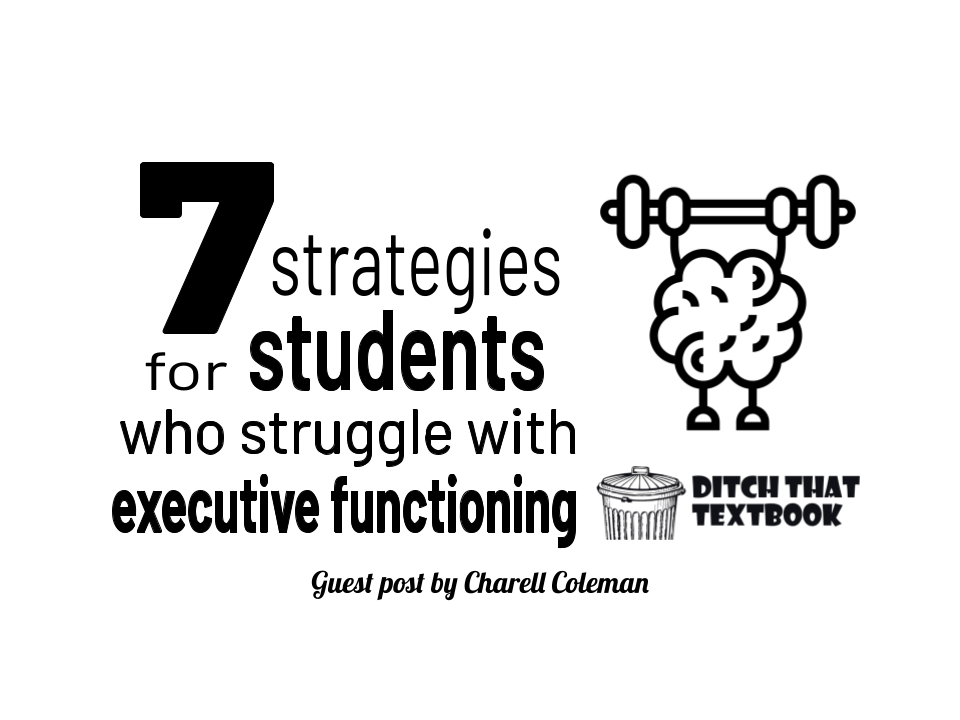
Executive functioning helps students get tasks done and work through their day. Here's how you can support students who struggle.
This post is written by Charrell Coleman, author, blog content creator, educator, presenter of Student Engagement and Executive Functioning Matters, book junkie, self help/care enthusiast, mother & calligraphist. You can follow her on Twitter, Facebook and Instagram @heartucator. Check out her blog at teachyourheartoutcon.com/blog.
Have you ever wondered why students with learning or behavior issues in school perform better in some classes, poorly in others and inconsistent in others? Typically if this is the case in elementary school for a student, it only worsens by secondary level.
Executive function profiles are not equally problematic in different settings. Research shows that students with developmental executive function weakness generally require far greater adult supervision than their developing peers across grade levels. (Barkley, 1997, 2006). Therefore these students need strategies that move them to the front of the class. We want to assure these students are not left behind!
Skills that help students with organization, homework completion, time management, and impulse control are executive functioning skills. Although the ultimate goal is for students to learn how to complete tasks independently, teaching and modeling strategies will help students move towards independence rather than forcing them to use skills they don't yet have.
7 strategies for students who struggle with executive functioning
1. Provide students with a surrogate brain while their frontal lobe is in developmental stage.
Giving students an "artificial frontal lobe" is almost like giving the brain a booster or a head start in the learning process. Consider these strategies as adding artificial flavoring to make it just the right taste of learning!
- Give one-on -one instruction after group or whole group lesson
- Provide guided practice as you teach the lesson
- Start homework in class so that students can ask any questions. During this time, the teacher will demonstrate the expectation of the homework task.
- Use a project planning form for long term projects
- Sit with students to plan out time projected for each task-
- Post visual reminders in students’ immediate sight, whether it is on their desk, on the wall, or the board
This includes writing strategies, reading strategies, math formulas.
- Social Mentoring: A trained adult provides the students with severe executive deficits with an adult or more socially skilled peer for specific periods of the day to serve as their social coach.
2. Teach students skills in an explicit and systematic way.
3. Teach skills in real life context.
4. Help with the working memory overload.

You might hear students say things like, “I can't keep all my thoughts in my head” or “everything you're saying is just too much, and it makes my head hurt.” These are signs of memory overload.
Here are a few valuable tools:
- Encourage students to use sticky notes to remember tasks in each class to avoid memory overload by the end of the day. Transfer this information to one centralized place before the midpoint in their day if possible.
- Use apps like Forest to avoid distractions while working on a task.
- Break tasks into smaller tasks. For example, when writing, have students start with the pre-write process. Pause and conference with students before beginning the planning and outlining process.
- Use rubrics and checklists in all writing tasks for a visual. Now turn these rubrics or checklists into your grading rubric as a time saver!
The stronger your working memory, the less your brain has to work. This can make room for more brain power when encountering new challenges. Russell Barkley calls our working memory our brain’s GPS.
5. Provide repeated opportunities for guided practice
- Use guided oral reading practice exercises. Many students with executive function skills find reading boring and laborious.
- Use writing templates, math templates, reading diagrams throughout the year.
- Present new skills in a spiraling manner. Keep reviewing skills.
- Do role-playing and demonstrations of class rules once a week.
6. Develop routines and stick to them
Kiss your brain with consistency! The brain loves predictability!
- When students enter your learning space, always have a calendar with upcoming assessments and due dates of an assigned task.
- Set aside the same day each week to plan out the week on their digital or paper calendar (including students’ extracurricular activities and family events). This will look different for each student. I create a Google Calendar for the class and share it with them to edit their calendars. Students add their extracurricular and family events to this calendar.
- At the beginning of the year, develop a homework and project turn-in (this includes where things are physically turned in). Try to stick to this and not tweak this too much. Keep the same routines so that students know where to find things.
- Try to arrange for your test to be on a specific day of the week if possible. From a school-wide approach, this looks like :
Test Day | Subject |
Monday | Math |
Tuesday | Science |
Wednesday | Social Studies |
Thursday | English/Reading |
Friday | Spelling |
- Have the schedule for the day printed on the board when students walk in each day
- Develop classroom-wide organizational systems such as English items on blue paper, Math items on white paper, reading on lavender paper
- Keep binder dividers in sync with color coding and in a specific order school-wide.
- Use the same heading for papers school-wide. i.e. Decide if students need a Name, Date, Class Sec, and Topic and whether this should be on the left or right side of the paper.
- Perform binder checks so that students know that the organization of the binder is essential.
7. Allow students to just be human in your presence
- Open up class with check-ins. Take time to ask each student how they are Arriving at class. I created my own set of emojipresssions, google slides and use online resources.
- While students are working on a task, play calming music with interactive backgrounds on a projection board when possible help to set the mood for learning and settles the nervous system
- Practice simple meditation. It is one of the most effective ways to access the use of your executive functions. This helps students who need assistance with self-awareness and stabilizes the nervous system. Calm App and Headspace App have many features for the classroom.
- Use mindfulness techniques. You can find yoga and tai chi quick exercises on YouTube when you notice students need to self-regulate.
- Allow Brain Breaks. Students enjoy having dance parties to rejuvenate the dendrites in the brain. GoNoodle has a variety to choose from.
- Allow students to share in your mistakes and challenges. Say aloud to them that you have made a mistake and are frustrated. (For example: "Girls and boys, I have no idea why I keep spelling that word incorrectly. This frustrates me. Are there any ideas on how I can help myself break this cycle?" Start the discussion about how you handled the situation and how you could have handled the situation differently.) Students will begin to view you as a person who is just human and gain tremendous respect for you. This also creates a safe space for students to make your flaws transparent to them!
What strategies do you use to help students who struggle with executive functioning? Share in a comment below!




thanks for the helpful information , unique article
Thank you Sarah for your feedback. I am a mother to a 14 year old son who is struggling in the 9th grade and HATES school. He is having trouble keeping up.
Any recommendations?
Hello,
Great post. These are strategies I look forward to employing with my learners next school year.
I am facing a few of these issues as well…………..Zianefacdroitsp
Hi!
Thank you for this blog post. Executive functions are in the frontal cortex of the brain as discussed here. The intricacies of brain variations are a critical factor inside and outside the classroom.
I’m an ADHD Coach, former teacher, and a proud woman with ADHD. I dropped out of high school at age 16, I simply didn’t have the executive function maturity to pack my school bag.
10 years later I was able to access tertiary education. No-one was more surprised than me when, 4 years later, I graduated with First Class honours. Still undiagnosed then, but interest and multiple means of representation (gone were pen and paper assignments!) removed many unconscious barriers.
You may understand a little why I love ‘Ditch that Textbook’, and am sometimes able to align Universal Design, multi-media and cognitive learning theories with suggested resources; to reach my clients falling through the cracks in education.
Kindest regards
Sarah Andrews